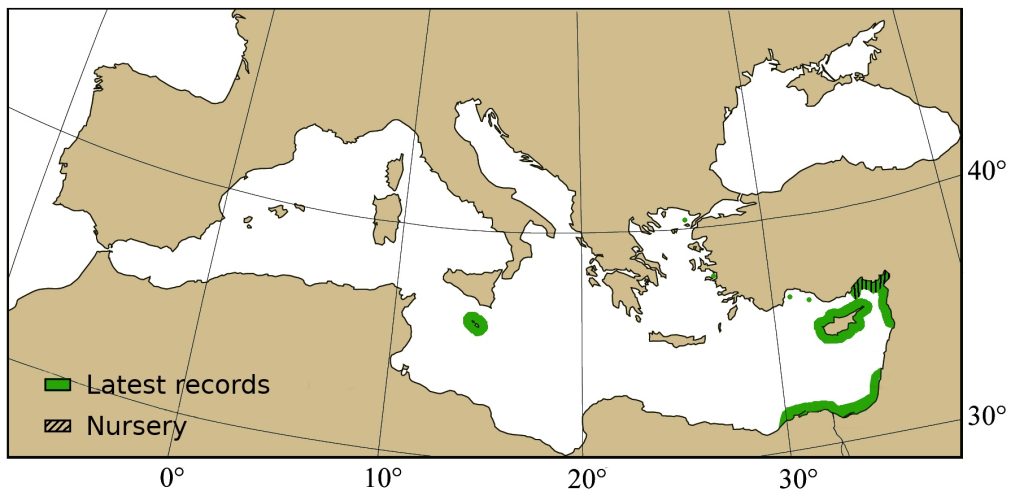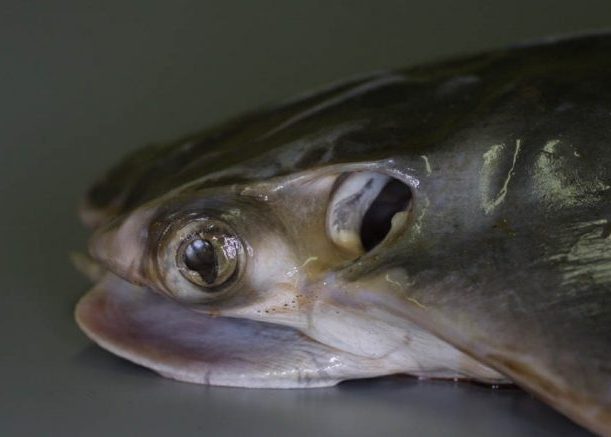Rhinoptera marginata
Common name : Lusitanian Cownose ray
Order: Myliobatiformes
Family: Rhinopteridae
Synonyms: Myliobatis marginata, Rhinoptera peli
Misidentifications: None
Short description
Medium to large species with lozenge-shape disk much broader than long. Head protruding from disk. Front of head distinctly concave. Deeply incised subrostal lob. Snout is divided into two parts. Eyes and spiracles oriented sideways. Broad mouth. Slender tail with a single dorsal fin and one or more spines on its base.
Color: Brown greenish to bronze dorsal surface. White ventral surface.
Measurements:
- Disk width (DW): 50-102 cm (max 200 cm)
Swimming pattern: Oscillatory locomotion.
Biology / Ecology
Feeds on bottom-living mollusks, crustaceans and fishes.
Behaviour: Gregarious, often forming large groups swimming near the surface.
Reproduction: Viviparous (aplacental viviparity with histotrophy). Size at maturity (DW): 66-80 cm female and 62-77 cm male. Gestation period: up to 1 year. Juveniles per litter: 1-6. Size at birth: ~23 cm.
Habitat: Bentho-pelagic in tropical and warm temperate coastal waters, shallow bays, lagoons and estuaries from surface to 100 m of depth.
Often forms large groups swimming in mid-water; quite destructive of commercial oyster and clam beds.
Distinguishing characteristics
- Front of head distinctly concave.
- Deeply incised subrostal lob.
- Snout is divided into two parts.
- One dart and a small dorsal fin at the base of the tail.
Myliobatiformes: No caudal and anal fin. Thin tail like a whip.
Rhinopteridae: Depressed body. Head protruding from disk. Two subrostral fins incised.
Distribution
Worldwide: Southern Spain to Senegal. Absent in Black Sea.
Mediterranean:
- Occurrence: Very rare. Single or sporadic captures in eastern Mediterranean. Seems absent in the western part of the Mediterranean.
- Latest records: Bay of Antalia – Turkey (2021), Egypt (2020), Mersin & Iskenderun bay – Turkey (2013), Cyprus (2004), Syria (2003).
- Locally extinct: Upper Tyrrhenian Sea (1972), Adriatic Sea (1948).

Any recent observation not on the map?
Contact us!
Conservation
Threats: Formerly a commercial species, now caught as bycatch in industrial, artisanal and subsistence fisheries, by pelagic and bottom trawl fisheries and with gillnets.
Protection level:
- Global: Critically Endangered (IUCN 2021, last assessment: 2020)
- Mediterranean: Data Deficient (IUCN 2016, last assessment: 2016)
- Europe: Data Deficient (IUCN 2015, last assessment: 2014)
Key references
- Ali M.F. 2018. An updated Checklist of the Marine fishes from Syria with emphasis on alien species. Mediterranean Marine Science 19(2): 388-393.
- Başusta N., Başusta A., Çiçek E., Cicia A. M., Sulikowski J. A. 2022. First Estimates of Age and Growth of the Lusitanian Cownose Ray (Rhinoptera marginata) from the Mediterranean Sea. Journal of Marine Science and Engineering 10(5): 685.
- Carpentieri P., Nastasi A., Sessa M., Srour A. 2021. Incidental catch of vulnerable species in Mediterranean and Black Sea fisheries – A review. General Fisheries Commission for the Mediterranean. Studies and Reviews 101: I-317.
- Golani D. 2006. Cartilaginous fishes of the Mediterranean coast of Israel. In: Başusta N., Keskin Ç, Serena F., Séret B. (eds) Proceedings of the International Workshop on Mediterranean Cartilaginous Fish with Emphasis on Southern and Eastern Mediterranean, pp. 95-100. Istanbul, Turkey, Turkish Marine Research Foundation.
- Hadjichristophorou M. 2006. Chondrichthyes in Cyprus. In: Basusta N., Keskin C., Serena F., Seret B. (Eds), Proceedings of the Workshop on Mediterranean Cartilaginous Fish with Emphasis on Southern and Eastern Mediterranean No. 23. Turkish Marine Research Foundation, Ataköy Marina, Istanbul, Turkey.
- Kabasakal H., Oruç A., Kalecik E., Sevim E., Araç N., Linç C. İ. 2024. Recent occurences of Rhinoptera marginata and Mobula mobular in Turkish Aegean and Mediterranean waters. Annales: Series Historia Naturalis Vol. 34, No. 1: 51-60.
- Mancusi C., Baino R., Fortuna C., De Sola L.G., Morey G., Bradai M.N., Kallianotis A., Soldo A., Hemida F. Saad A.., Dimech M., Peristeraki P., Bariche M., Clo S., De Sabata E., Castellano L., Garibaldi F., Lanteri L., Tinti F., Pais A., Sperone E., Micarelli P., Poisson F., Sion L., Carlucci R., Cebrian-Menchero D., Seret B., Ferretti F., El-Far A., Saygu I., Shakman E., Bartoli A., Guallart J., Damalas D., Megalofonou P., Vacchi M., Colloca F., Bottaro M., Notarbartolo Di Sciara G., Follesa M.C., Cannas R., Kabasakal H., Zava B., Cavlan G., Jung A., Abudaya M., Kolitari J., Barash A., Joksimovic A., Cetkovic I., Marceta B., Gonzalez Vilas L., Tiralongo F., Giovos I., Bargnesi F., Lelli S., Barone M., Moro S., Mazzoldi C., Abella A., Serena F. 2020. MEDLEM database, a data collection on large Elasmobranchs in the Mediterranean and Black seas. Mediterranean Marine Science 21(2): 276-288.
- Ragheb E., Hasan M.W.A. 2021. First record of Pteroplatytrygon violacea (Bonaparte, 1832) with annotation of cartilaginous fishes by-catch by gill nets (Egyptian Mediterranean). The Egyptian Journal of Aquatic Research 47(4): 387-392.
- Saad A., Ali M., Seret B. 2006. Shark exploitation and conservation in Syria. In: Başusta N., Keskin C., Fabrizio S, Seret B. (Eds.) Proceedings of the International Workshop on Mediterranean Cartilaginous Fish with Emphasis on Southern and Eastern Mediterranean, pp. 202-208. Istanbul, Turkey, Turkish Marine Research Foundation.
- Serena F., Relini G. 2005. Use of scientific campaigns (trawl surveys) for the knowledge of the sensitive habitats: a review of the MEDITS, GRUND and APHIA data with special attention to the Italian seas. In: Başusta N., Keskin C., Fabrizio S, Seret B. (Eds.) Proceedings of the International Workshop on Mediterranean Cartilaginous Fish with Emphasis on Southern and Eastern Mediterranean, pp. 95-100. Istanbul, Turkey, Turkish Marine Research Foundation.
- Tıraşın E.M., Başusta N. 2018. Near-term embryos and gravid females of Lusitanian cownose ray (Rhinoptera marginata) in Mersin Bay, eastern Mediterranean Sea. Marine and Freshwater Research 69(9): 1365-1371.



